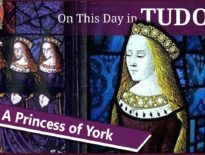On this day in Tudor history, 14th November 1541, an inventory was taken of "the goods and chattels, lands and fees of" Thomas Culpeper, a groom of King Henry VIII's privy chamber and a man who had been having secret meetings with Catherine Howard, Henry VIII's fifth wife.
An inventory had also been taken of the possessions of Jane Boleyn, Lady Rochford, wife of the late George Boleyn, a woman who had allegedly helped the queen meet with Culpeper.
But what was going on in November 1541 and what was listed in these inventories?
Find out in today's talk.
Also, on this day in Tudor history, 14th November, the Feast of St Erkenwald, there may have been two royal Tudor weddings. We know that Catherine of Aragon married Arthur, Prince of Wales, on 14th November 1501, but chronicler Edward Hall gives 14th November 1532 as the date of a secret wedding for King Henry VIII and Anne Boleyn, Marquess of Pembroke, in Dover. Find out more about these two royal weddings in last year’s video:
Also on this day in history:
- 1531 – Birth of Richard Topcliffe, member of Parliament, priest-hunter, interrogator and torturer, in Lincolnshire. During the reign of Elizabeth I, Topcliffe was issued with warrants allowing him to use torture when examining imprisoned Catholic recusants and priests. His famous victims included Robert Southwell, John Gerard and Henry Garnet.
- 1539 – Hanging of Hugh Cook (Faringdon), Abbot of Reading, for treason, for upholding papal supremacy. He was born Hugh Cook, but took the name Faringdon when he took Benedictine orders.
- 1559 – Death of Thomas Brydges, landowner, member of Parliament and administrator. He was buried at Chadlington in Oxfordshire. Brydges had been present at the execution of Lady Jane Grey while serving as Deputy Lieutenant of the Tower of London.
- 1581 – Death of Richard Bristow, Roman Catholic priest and scholar, while in prison for his faith. He died of consumption. Bristow is known for being one of the men responsible for the translation of the Douay-Rheims Bible.
Transcript:
By this day in Tudor history, 14th November 1541, things were not looking good for Thomas Culpeper, a member of the king’s privy chamber and a man who Francis Dereham, secretary to Queen Catherine Howard, had claimed “had succeeded him in the Queen’s affections”. It was on this day that an inventory was taken “of the goods and chattels, lands and fees of Thos. Culpeper, the younger”.
Now before I talk about the inventory, let me just explain the background to this. On 2nd November 1541, just days after returning from his progress to the North with his fifth wife, Catherine Howard, Henry VIII had been informed by Archbishop Cranmer that allegations had been made concerning Catherine’s past. It was claimed that during her time in her stepgrandmother the Dowager Duchess of Norfolk’s household, that Catherine had had a relationship with her music tutor, which went as far as heavy petting, and a full sexual relationship with the dowager duchess’s employee, Francis Dereham. During the subsequent investigation, it came to light that Catherine had had secret meetings during the royal progress with Thomas Culpeper, helped by one of her ladies, Jane Boleyn, Lady Rochford.
Culpeper was arrested around 12th/13th November and interrogated. During the interrogations, he admitted to having a romance with Catherine before she married the king and then this romance being revived after her marriage. He denied having sex with Catherine but confessed that the couple intended to “do ill” with each other. Intention was all that was needed to seal the couple’s fate because the 1534 Treason Act stated that traitors were those who “do maliciously wish, will or desire by words or writing, or by craft imagine, invent, practice or attempt any bodily harm to be done or committed to the King’s most royal person”. Sleeping together, with its risk of pregnancy, would impugn the succession.
Culpeper was in trouble and while he was imprisoned, an inventory of his possession was taken on this day in 1541. The inventory included his possessions at Westminster Palace, which included “two caps of velvet that the King gave him” along with other items of clothing and “some swords, daggers, and sundries”; his horses, harnesses for the horses, and furniture “at various places”; “Debts and ready money owing to him”; revenues from his lands, which included several manors and a former monastery in Kent; his various offices (the king had been generous with these); his possessions in his house at Greenwich; and his furniture, hangings and possessions “within the great lodge at Southfryth of Master Culpepper”.
By this time, an inventory had also been taken of the possessions of the lady who had helped the couple, Jane Boleyn, Lady Rochford. The list included a large amount of plate, jewels including “a broach with an agate, a cross of diamonds with three pearls pendant, a flower of rubies, a flower with a ruby and a great emerald with a pearl pendent, a tablet of gold with black, green, and white enamelled, a pair of bracelets of red cornelyns, a pair of beads of gold and stones, a broach of gold with an antique head and a white face.”
And apparel including kirtles of black velvet and black satin, a nightgown of black taffeta, a gown of black damask, and a gown of black satin. It is interesting to note all the items of clothing listed in this inventory are black. Was Jane wearing black to demonstrate her wealth and status, or was she still wearing mourning attire following her husband George Boleyn’s execution in 1536? It’s hard to know.
Thomas Culpeper was found guilty of “high treason against the Kinges Majestie in mysdemeanor with the Quene”, along with Francis Dereham at a trial at Guildhall, London, on 1st December 1541. Both men were condemned to death and executed at Tyburn on 10th December 1541; Culpeper was beheaded and Dereham suffered a full traitor’s death.
Jane Boleyn, Lady Rochford, was beheaded along with her mistress, Queen Catherine Howard, at the Tower of London on 13th February 1542.



Leave a Reply